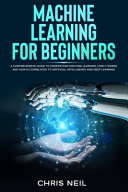Product desciption
Machine Learning For Beginners A Comprehensive Guide To Understand Machine Learning How It Works And How Is Correlated To Artificial Intelligence And Deep Learning Neil by Neil, Chris 9781801574563, 1801574561 instant download after payment.
Do you want to understand machine learning? How it works and how is correlated to artificial intelligence and deep learning? If yes, then keep reading... Machine Learning is based on mathematics, specifically statistics. It is a probabilistic discipline that began in the 1950s. Despite initial enthusiasm, research and development in Machine Learning languished for over 30 years, suffering from twin ills of a lack of data to work with and computers that were too slow to effectively work with what data they had. It is no accident Machine Learning is coming into its own over the last 10 years. Until we began creating and storing massive amounts of data about our world, ML was mostly an idea in the minds of statisticians. And until computers reached a level of speed and power where these massive data sets could be ingested in a reasonable amount of time, the revolution couldn't happen. But as we digitize information about our world and ourselves, and computers continue to increase in speed and capacity exponentially, the ability for Machine Learning to learn from our data grows in depth and accuracy. Looking to the future, we can see only more and more data collection about our world, faster computer chips, and data transfer, and more avenues for ML to develop in, to grow and learn, and to serve humanity. When most people think of machine learning, they either have no idea what it is, or they automatically think about artificial intelligence in the form of a robotic species that rivals humans. While these fascinating subspecies may one day exist as the result of machine learning developments, right now the primary focus is on how machine learning programs can become excellent at very specific tasks. Most machine learning technology is developed in such a way that it is excellent at performing one or, at most, two tasks. By focusing entire technology on one single task, they can ensure that it runs that task perfectly, and that it does not get confused between the tasks that it is trying to accomplish. While simple computing software like the one that runs your computer can easily run multiple programs at once with little chance of crashing, the technology that is used to run machine learning technology is far more complex. As researchers study it, they strive to keep the algorithms mostly separate, or specifically focused on completing just one goal, on minimizing room for error. It is likely that as we become more familiar with machine learning technology and more educated in the algorithms, we will start to see more and more machines completing multiple tasks, rather than just one. At this point, that is the long-term goal for many scientists who want to see these machines becoming more efficient, and requiring less hardware. After all, the hardware used to run some of these machines is not always the greenest technology, so the fewer hardware casings that technology needs to be stored in, the less of a footprint the technology sector will have on the planet. This book aims to educate you on the truth about machine learning. This book gives a comprehensive guide on the following: What is Machine Learning? Machine Learning Categories Sectors and Industries that use Machine Learning Fundamental Algorithms Regression Analysis Benefits of Machine Learning Deep Learning Deep Neural Network Big Data Analytics Big Data Analysis Tools How Companies Use Big Data Data Mining and Applications ... AND MORE!!! What are you waiting for? Click buy now!!!!!


